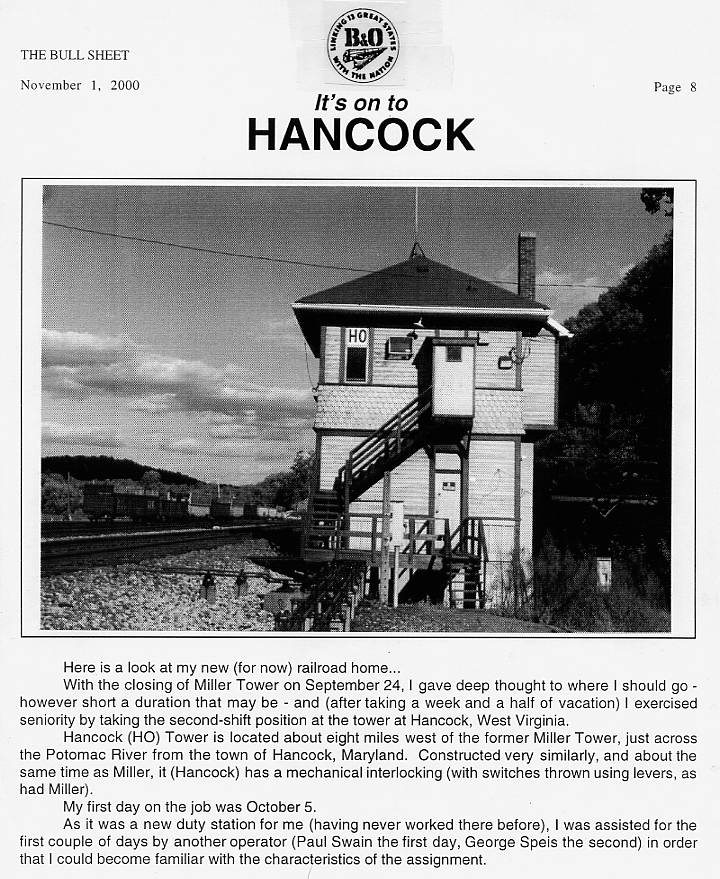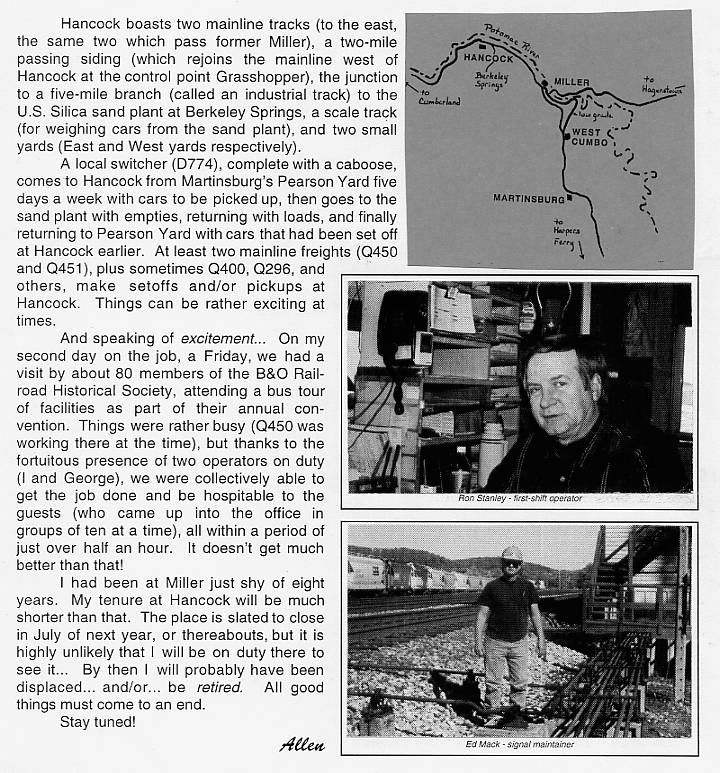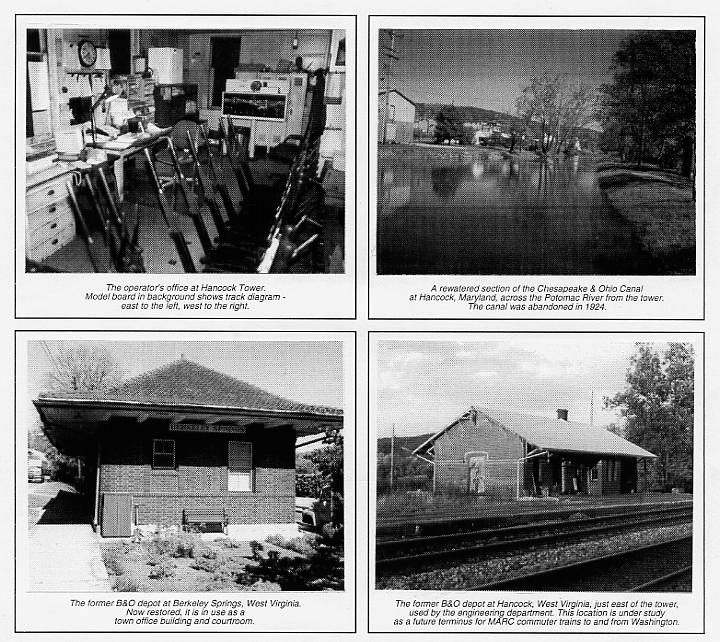
November 2000
Amtrak Acela Express to Begin December 11
Amtrak has announced the introduction of revenue service of its long-awaited Acela Express for December 11. Tickets will go on sale November 29. There will be a ceremonial launching of the service on November 16 with day long activities running from Washington north to New York and Boston. Amtrak will use the interval between the ceremonial launch of service and the start of regularly scheduled service to run special preview trains and to run charter service for professional sports teams. The first revenue service will involve a single round trip serving 11 intermediate stops between Washington and Boston. Additional service will be offered as equipment becomes available, and the second revenue offering will include a 'Super Express' running non-stop between Washington and New York. By the time all 20 trainsets are delivered next summer, Amtrak will be running 19 round trips daily between Washington and New York, and 10 round trips between New York and Boston. Each train will consist of a locomotive on each end with six passenger cars in between, including a first-class car, four business-class cars, and a cafe car. Seating capacity will be for 304 customers.
Lee Sargrad to Head Amtrak Mail & Express Unit
Amtrak has announced the consolidation of its mail and express business under the leadership of Lee H. Sargrad, 46, who will serve as the unit's president. His career has spanned 15 years in the rail freight industry, most recently as vice president of sales and marketing for Triple Crown Services.
Management Jobs to be Cut, Bonuses Eliminated, CSX Says
CSX has instructed each department to assess the work its people do and "to identify work that is unnecessary or redundant," over the next several weeks. In a letter to employees on October 4 from Bill Ryan, senior vice president-human resources, it was explained that the company's cost structure continues to be too high and a significant barrier to generating the financial performance of which the company is capable. "As that process goes forward, some non-union jobs will be eliminated." The departmental reviews will be conducted at CSX Corporation, as well as its three business units - CSX Transportation, CSX Intermodal, and CSX Technology. "It is anticipated that these reductions will be involuntary," the letter added. It was also explained that bonuses will not be paid to non-union employees for this year, beyond a special payment made earlier in 2000. Most of the staffing adjustments will occur in headquarters functions, according to the letter, with minimal impact in field operations. Affected employees will be offered transition benefits.
CSXT Customers May Now Trace Cars Via Wireless Internet
CSXT now offers customers the convenience and innovation of tracing rail cars via the wireless internet. "CSXT was the first railroad to offer an internet-based customer service solution with TWSNet, and now we are leading the industry's expansion of electronic commerce to the wireless internet," said Chuck Wodehouse, president of CSX Technology, in a press release.
Railroad Retirement Bill Fails to Reach Senate Vote
The Railroad Retirement and Survivors' Improvement Act of 2000 (H.R. 4844), the so-called 60/30 Bill, failed to reach a vote in the U.S. Senate. The bill had passed the House of Representatives by a vote of 391 to 25 on September 7, and it later passed on a voice vote by the Senate Finance Committee. The legislation would have allowed unreduced retirement benefits to railroaders retiring at age 60 with 30 years of service, five-year vesting instead of the current ten, and increased benefits for widows and widowers.
STB Issues Proposed Merger Rules
[From CSXT Midweek Report, October 5, 2000] . . . The Surface Transportation Board has proposed rules that are likely to make railroad mergers more difficult. If implemented, the rules would require railroads to make specific proposals to increase competition by other railroads after a merger. And the board said it would require more evidence than in past cases that proposed mergers are in the public interest. "The proposed new rules would substantially increase the burden on applicants to demonstrate that a proposed transaction is in the public interest, requiring them, among other things, to demonstrate that the transaction would enhance competition as an offset to negative impacts resulting from service disruptions and competitive harms likely to be caused by the merger," the STB said. The board imposed a 15-month moratorium on all rail mergers earlier this year, blocking the proposed CN-BNSF merger. CSX will participate fully in the period for public comments over the next three months. Final rules will be imposed by June 11, 2001, when the moratorium ends.
Pooch Earns Her Keep on CSXT Police Force
[From CSXT Midweek Report, October 12, 2000] . . . CSXT police have a new agent - Leska. A German shepherd, Leska is the first member of CSXT's K-9 police unit, responsible for security of shipments in Chicago. Leska's partner is special agent Paul Forsyth. Together, Leska and Forsyth made their first arrests of suspected burglars on August 10, just a few days after the two-year-old dog joined the CSXT police. "The first time I took her on foot patrol of CSX Intermodal's 59th Street ramp, she was very excited," Forsyth says. "She remembered her training in the rail yards and knew it was time to work. Employees are glad to see us." Forsyth has familiarized Leska with CSXI ramps at 59th and 63rd streets and Bedford Park, and tracks south of Park Manor, and on the Union Pacific hill between 115th and 130th streets. When not working, Leska likes to relax, listening to her favorite song, "Who Let the Dogs Out?"
Williston Depot Refurbished for CSXT Engineering Offices
[From CSXT Midweek Report, October 19, 2000] . . . Williston Depot, south of Gainesville, Florida, has been transformed from a dilapidated eyesore into a modern office building with a restored historic exterior. The work was completed almost entirely with CSXT employees. "The plumbers, electricians and carpenters all did an excellent job of pulling together to create a building that our people can be proud of," said John Morbitzer, supervisor-facilities. "The regional office played a major role by giving the craftsmen the time to do the job." A plaque listing the names of who worked on the project was attached to the building at a dedication ceremony last Monday (October 16). The small former freight depot is thought to have been constructed in the 1930's and was used to load various commodities, including, at one time, 72 carloads of pickles. Eventually, it became the roadmaster's office and section engineering and signal headquarters. The building deteriorated badly over the years and required a complete interior renovation. Outside, employees saved the cypress exterior and most of the original architectural features. "We've had a lot of favorable comments from the people of Williston, and the work environment for our employees is much improved," said Jimmy Neece, regional manager-facilities.
'Star Wars' Test Impresses FRA Officials
[From CSXT Midweek Report, October 19, 2000] . . . A test of Communications Based Train Management - also known as Star Wars - took place over the Augusta, Georgia-Spartanburg, South Carolina, corridor last week. That 125-mile single-track corridor uses Direct Traffic Control - verbal authorities from the Operations Center in Jacksonville granting access to each block, or segment, rather than wayside signals. The test was designed to demonstrate the system to top officials of the Federal Railroad Administration, other railroads, labor organizations and suppliers. 'Star Wars' is what train crews on the Augusta-Spartanburg corridor call CBTM, which is a form of Positive Train Control that incorporates global positioning satellite technology. The locomotive engineer must respond to warnings or acknowledge prompts on a cab monitor concerning a range of safety issues - switches aligned properly, permission to proceed through track work zones and adherence to speed limits, for example. If the engineer doesn't take action to slow the train or acknowledge the prompts, the train is automatically brought to a safe stop... "This system has the capability of future applications and enhancements," said Tom Schmidt, vice president-engineering. "But more than that, it's another guarantee that our train crews will go home safely." Schmidt is leading the more than three-year-old effort to develop Star Wars along with Denise Lyle, director-advance train control projects, and a team from Wabtec Railway Electronics. The FRA's George Gavalla, associate administrator of safety, rode on a recent demonstration trip and congratulated CSXT. "We think that whole field of computer based train control technologies holds a lot of promise for the industry," Gavalla says. "It promises to dramatically improve safety and improve efficiency of operations. We applaud CSXT for taking the initiative to help develop computer based train control, and we want to work with you to make it the best system that it can be."
Of Keystone Heritage
[By Rich Ballash] . . .
It was bound to happen!... Welcome to the brand new PENN CENTRAL HISTORICAL SOCIETY! Many point their noses upward and say, "But why?" PC spanned a mere eight ill-fated years, which saw all but collapse of a once-magnificent Northeastern rail network. But it looked so promising... The two giants, forging a new alliance that would appear to be a shining star of transportation's future. And yes, the promise quickly turned into despair. We all remember the weeds filling the mainline gauge, with rocking and swaying trains powered by a multitude of battered first-generation diesel relics. But wait! Would you rather have the early '70's, or today's streamlines, and now dismembered Big X? Well, let's see... We had the mostly-intact physical plant, all of the old main lines and many branches, hundreds of towers, countless depots, and a scant police force that would rather chase one away than arrest you! We had empty, but plentiful, passenger trains, with open vestibules and observation cars... and dome cars; oh, those wonderful dome cars! Before Amfleet-I's teeny airplane windows, we had big, BIG picture windows, some which would actually open! (Remember before we had to endure hermetically-sealed cigar tubes? And how many times have you hit your head on those stupid luggage rack bulkheads?) We had cabin cars (and yes, cabooses, too - snicker snicker!). We had those beautiful position-light and color-position-light signals, and on the Erie and Big 4, spectacular semaphores! You could tell what railroad you were on just by looking at the signals... Now try that! We had railroad people who could and would give you grand tours and many other special privileges, without fear of losing their jobs for doing so from an unseen "godfather" megaboss 2000 miles away. We had jointed rail, and real honest-to-goodness human beings give your train a rolling runby, not "Speak-and-Spell" synthesized computer voices from trackside tin boxes! Oh, this could go on and on and on! Indeed! Now!... Once more... Why is there now a PENN CENTRAL HISTORICAL SOCIETY? It's simple. Because there was just so much more to love! And that promise! What a shame it just didn't work! Black is back, and I don't know about you, but worms would have been so much more welcome than horse poopie around these parts! And a basically intact Pennsy and Central network would have been so much better for our region than the bisected, piecemeal mess we have out there today! So good luck, guys! I wish you much success on your endeavor! Your effort toward preservation and historical record is certainly a grand responsibility OF KEYSTONE HERITAGE! RDB


